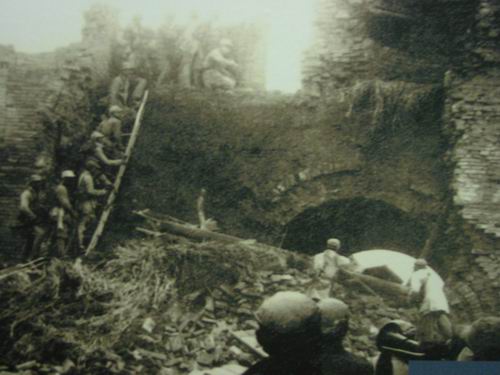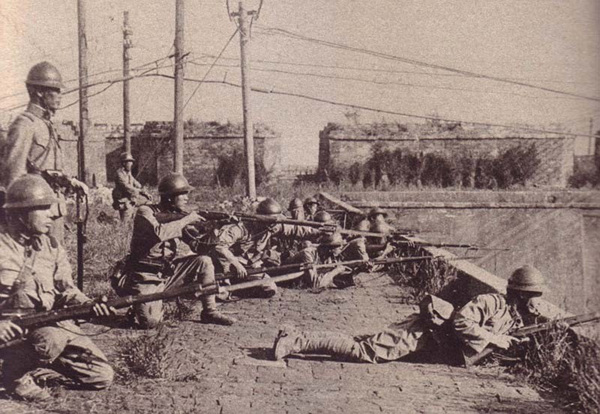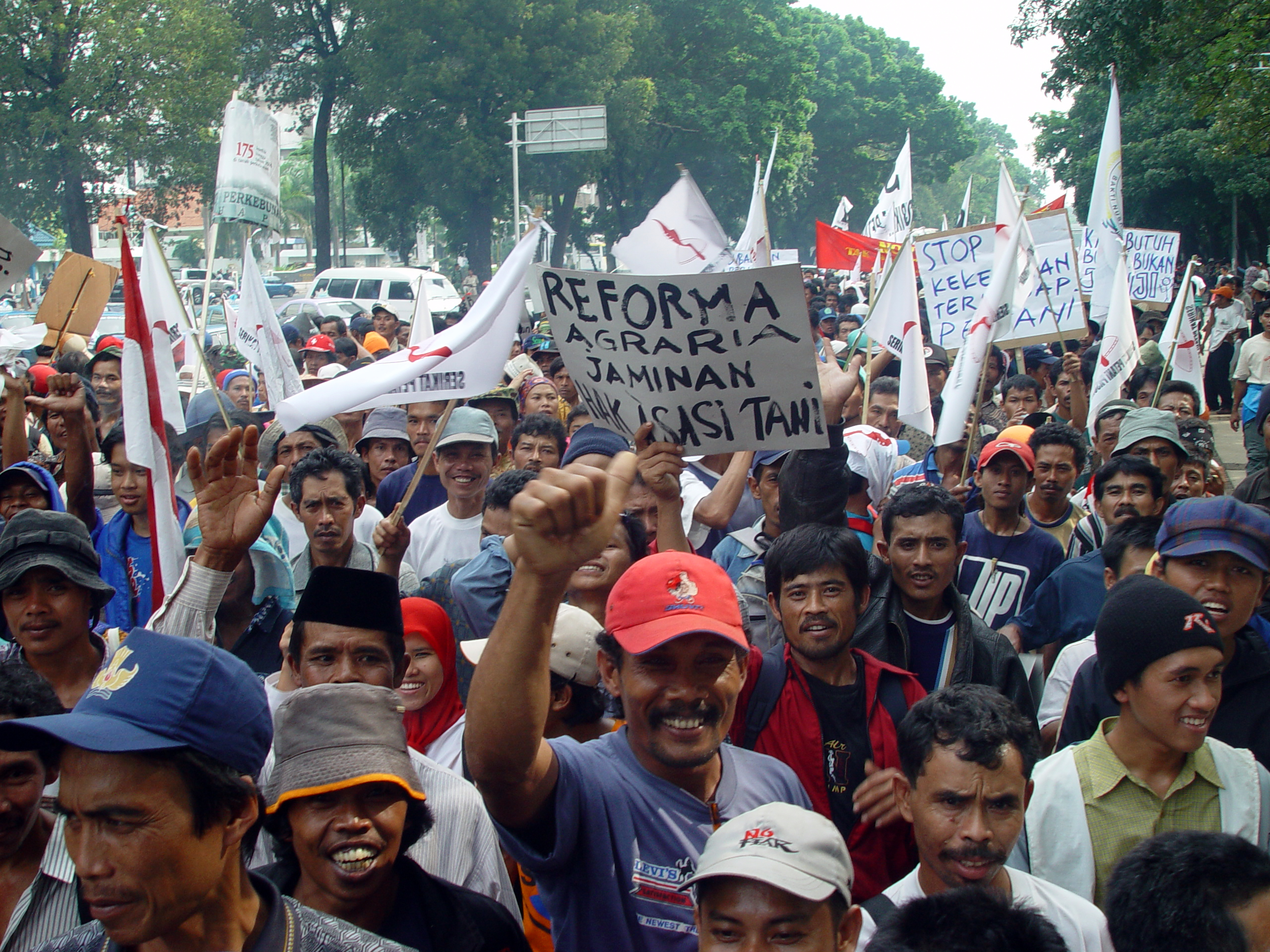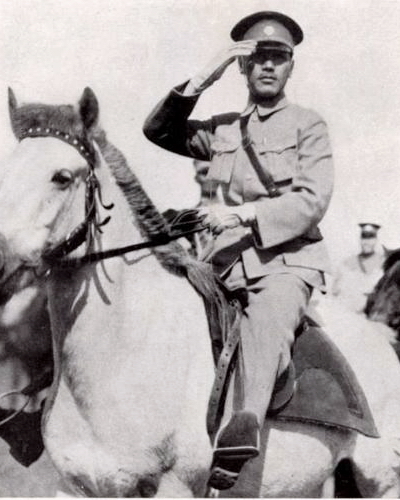|
Chinese Revolution (1949)
The Chinese Communist Revolution was a social and political revolution in China that began in 1927 and culminated with the proclamation of the People's Republic of China (PRC) in 1949. The revolution was led by the Chinese Communist Party (CCP), which afterwards became the ruling party of China. The political revolution resulted in major social changes within China and has been looked at as a model by revolutionary Communist movements in other countries. During the preceding century, termed the century of humiliation, the decline of the Qing dynasty and the rise of foreign imperialism caused escalating social, economic, and political problems in China. The Qing collapsed in 1912 and were replaced with the Republic of China, which had itself fallen into warring factions by 1917. A small group of urban intellectuals, inspired by the October Revolution and European socialist ideas, founded the CCP in 1921. They created an alliance known as the First United Front with the much l ... [...More Info...] [...Related Items...] OR: [Wikipedia] [Google] [Baidu] |
Chinese Civil War
The Chinese Civil War was fought between the Kuomintang-led Nationalist government, government of the Republic of China (1912–1949), Republic of China and the forces of the Chinese Communist Party (CCP). Armed conflict continued intermittently from 1 August 1927 until Communist victory resulted in their total control over mainland China on 7 December 1949. The war is generally divided into two phases with an interlude: from August 1927 to 1937, the First United Front alliance of the KMT and CCP collapsed during the Northern Expedition, and the Nationalists controlled most of China. From 1937 to 1945, hostilities were mostly put on hold as the Second United Front fought the Second Sino-Japanese War, Japanese invasion of China with eventual help from the Allies of World War II. However, armed clashes between the groups remained common. Exacerbating the divisions within China further was the formation of the Wang Jingwei regime, a Japan-sponsored puppet government led by Wang ... [...More Info...] [...Related Items...] OR: [Wikipedia] [Google] [Baidu] |
Republic Of China (1912–1949)
The Republic of China (ROC) began on 1 January 1912 as a sovereign state in mainland China following the 1911 Revolution, which overthrew the Manchu people, Manchu-led Qing dynasty and ended China's imperial China, imperial history. From 1927, the Kuomintang (KMT) Northern expedition, reunified the country and initially ruled it as a one-party state with Nanjing as the national capital. In 1949, Nationalist government, the KMT-led government was defeated in the Chinese Civil War and lost control of the mainland to the Chinese Communist Party (CCP). The CCP Proclamation of the People's Republic of China, established the People's Republic of China (PRC) while the ROC was forced to Retreat of the government of the Republic of China to Taiwan, retreat to Taiwan; the ROC retains control over the Taiwan Area, and political status of Taiwan, its political status remains disputed. The ROC is recorded as a founding member of both the League of Nations and the United Nations, and previous ... [...More Info...] [...Related Items...] OR: [Wikipedia] [Google] [Baidu] |
Xi'an Incident
The Xi'an Incident was a Chinese political crisis that lasted from 12 to 26 December 1936. Chiang Kai-shek, the leader of the Nationalist government of China, was arrested in Xi'an by soldiers of the Northeastern Army under the command of General Zhang Xueliang. Zhang demanded that Chiang agree to a ceasefire in the Chinese Civil War so that the Nationalist government could ally with the Chinese Communist Party (CCP) against Japanese expansionism. Negotiations were held between Chiang and the CCP, resulting in verbal agreement on the broad outlines of an alliance. After Chiang was released, he publicly renounced the terms he had agreed to in captivity, but secretly continued the negotiations that would result in the Second United Front. The Xi'an Incident followed months of secret negotiations between the CCP and the Nationalists. Only minor progress had been made by December 1936. However, the CCP had also been negotiating directly with the Nationalist armies that surrounde ... [...More Info...] [...Related Items...] OR: [Wikipedia] [Google] [Baidu] |
Japanese Invasion Of Manchuria
The Empire of Japan's Kwantung Army invaded the Manchuria region of the Republic of China on 18 September 1931, immediately following the Mukden incident, a false flag event staged by Japanese military personnel as a pretext to invade. At the war's end in February 1932, the Japanese established the puppet state of Manchukuo. The occupation lasted until mid-August 1945, towards the end of the Second World War, in the face of an onslaught by the Soviet Union and Mongolia during the Manchurian Strategic Offensive Operation. With the invasion having attracted great international attention, the League of Nations produced the Lytton Commission (headed by British politician Victor Bulwer-Lytton) to evaluate the situation, with the organization delivering its findings in October 1932. Its findings and recommendations that the Japanese puppet state of Manchukuo not be recognized and the return of Manchuria to Chinese sovereignty prompted the Japanese government to withdraw from the L ... [...More Info...] [...Related Items...] OR: [Wikipedia] [Google] [Baidu] |
Yan'an Rectification Movement
The Yan'an Rectification Movement ( zh, s=延安整风运动, t=延安整風運動, p=Yán'ān Zhěngfēng Yùndòng) was a political mass movement led by the Chinese Communist Party (CCP) from 1942 to 1945. The movement took place in the Yan'an Soviet, a revolutionary base area centered on the remote city of Yan'an. Although it was during the Second Sino-Japanese War, the CCP was experiencing a time of relative peace when they could focus on internal affairs. The legacies of the Yan'an Rectification Movement proved fundamental to the subsequent history of the Chinese Communist Party, according to Kenneth Lieberthal. These included the consolidation of Mao Zedong's paramount role within the CCP, especially from 1942 to 1944, and the adoption of a party constitution that endorsed Marxist-Leninism and Mao Zedong Thought as guiding ideologies. This move formalised Mao's deviation from the Moscow party line and the importance of Mao's alleged 'adaptation of communism to the ... [...More Info...] [...Related Items...] OR: [Wikipedia] [Google] [Baidu] |
Yan'an Soviet
The Yan'an Soviet was a soviet governed by the Chinese Communist Party (CCP) during the 1930s and 1940s. In October 1936 it became the final destination of the Long March, and served as the CCP's main base until after the Second Sino-Japanese War. After the CCP and Kuomintang (KMT) formed the Second United Front in 1937, the Yan'an Soviet was officially reconstituted as the Shaan–Gan–Ning Border Region ( zh, first=t, s=陕甘宁边区, t=陝甘寧邊區, p=Shǎn gān níng Biānqū, w=Shan3-kan1-ning2 Pien1-ch'ü1). Yan'an is celebrated in CCP historical narratives as the most sacred of revolutionary sites and the birthplace of Mao Zedong Thought. Organization The Shaan-Gan-Ning base area, of which Yan'an was a part, was founded in 1934. During the Second Sino-Japanese War, the Shaan-Gan-Ning Border Region became one of a number of border region governments established by the Communists. Other regions included the Jin-Sui Border Region (in Shanxi and Suiyuan), the Jin-Ch ... [...More Info...] [...Related Items...] OR: [Wikipedia] [Google] [Baidu] |
Jiangxi Soviet
The Jiangxi Soviet, sometimes referred to as the Jiangxi-Fujian Soviet, was a soviet area that existed between 1931 and 1934, governed by the Chinese Communist Party (CCP). It was the largest component of the Chinese Soviet Republic and home to its capital, Ruijin. At the time, the CCP was engaged in a rural insurgency against the Kuomintang-controlled Nationalist Government as part of the Chinese Civil War. CCP leaders Mao Zedong and Zhu De chose to create the soviet in the rugged Jinggang Mountains on the border of Jiangxi and Fujian because of its remote location and defensible terrain. The First Red Front Army successfully repulsed a series of encirclement campaigns by the Kuomintang's National Revolutionary Army (NRA) during the first few years of the Soviet's existence, but they were eventually defeated by the NRA's fifth attempt between 1933 and 1934. After the Jiangxi Soviet was defeated militarily, the CCP began the Long March towards a new base area in the nor ... [...More Info...] [...Related Items...] OR: [Wikipedia] [Google] [Baidu] |
Mao Zedong
Mao Zedong pronounced ; traditionally Romanization of Chinese, romanised as Mao Tse-tung. (26December 18939September 1976) was a Chinese politician, revolutionary, and political theorist who founded the People's Republic of China (PRC) in 1949 and led the country from Proclamation of the People's Republic of China, its establishment until Death and state funeral of Mao Zedong, his death in 1976. Mao served as Chairman of the Chinese Communist Party (CCP) from 1943 until his death, and as the party's ''de facto'' leader from 1935. His theories, which he advocated as a Chinese adaptation of Marxism–Leninism, are known as Maoism. Born to a peasant family in Shaoshan, Hunan, Mao studied in Changsha and was influenced by the 1911 Revolution and ideas of Chinese nationalism and anti-imperialism. He was introduced to Marxism while working as a librarian at Peking University, and later participated in the May Fourth Movement of 1919. In 1921, Mao became a founding member of the ... [...More Info...] [...Related Items...] OR: [Wikipedia] [Google] [Baidu] |
Land Reform
Land reform (also known as agrarian reform) involves the changing of laws, regulations, or customs regarding land ownership, land use, and land transfers. The reforms may be initiated by governments, by interested groups, or by revolution. Land reform is often considered a contentious process, as land is a key driver of a wide range of social, political and economic outcomes. The structure and distribution of land rights has been linked to state formation, economic growth, inequality, political violence, and identity politics, making land reform highly consequential for the long-term structures of society. Overview Land reform may consist of a government-initiated or government-backed property redistribution, generally of agricultural land. Land reform can, therefore, refer to transfer of ownership from the more powerful to the less powerful, such as from a relatively small number of wealthy or noble owners with extensive land holdings (e.g., plantations, large ranches, or ... [...More Info...] [...Related Items...] OR: [Wikipedia] [Google] [Baidu] |
Shanghai Massacre
The Shanghai massacre of 12 April 1927, the April 12 Purge or the April 12 Incident as it is commonly known in China, was the violent suppression of Chinese Communist Party (CCP) organizations and leftist elements in Shanghai by forces supporting General Chiang Kai-shek and conservative factions in the Kuomintang (Chinese Nationalist Party or KMT). Following the incident, conservative KMT elements carried out a full-scale purge of communists in all areas under their control, and violent suppression occurred in Guangzhou and Changsha. The purge led to an open split between left-wing and right-wing factions in the KMT, with Chiang Kai-shek establishing himself as the leader of the right-wing faction based in Nanjing, in opposition to the original left-wing KMT government based in Wuhan, which was led by Wang Jingwei. By 15 July 1927, the Wuhan regime had expelled the Communists in its ranks, effectively ending the First United Front, a working alliance of both the KMT and CC ... [...More Info...] [...Related Items...] OR: [Wikipedia] [Google] [Baidu] |
Kuomintang
The Kuomintang (KMT) is a major political party in the Republic of China (Taiwan). It was the one party state, sole ruling party of the country Republic of China (1912-1949), during its rule from 1927 to 1949 in Mainland China until Retreat of the government of the Republic of China to Taiwan, its relocation to Taiwan, and in Taiwan Martial law in Taiwan, ruled under martial law until 1987. The KMT is a Centre-right politics, centre-right to Right-wing politics, right-wing party and the largest in the Pan-Blue Coalition, one of the two main political groups in Taiwan. Its primary rival is the Democratic Progressive Party (DPP), the largest party in the Pan-Green Coalition. As of 2025, the KMT is the largest single party in the Legislative Yuan and is chaired by Eric Chu. The party was founded by Sun Yat-sen in 1894 in Honolulu, Hawaii, as the Revive China Society. He reformed the party in 1919 in the Shanghai French Concession under its current name. From 1926 to 1928, the K ... [...More Info...] [...Related Items...] OR: [Wikipedia] [Google] [Baidu] |






